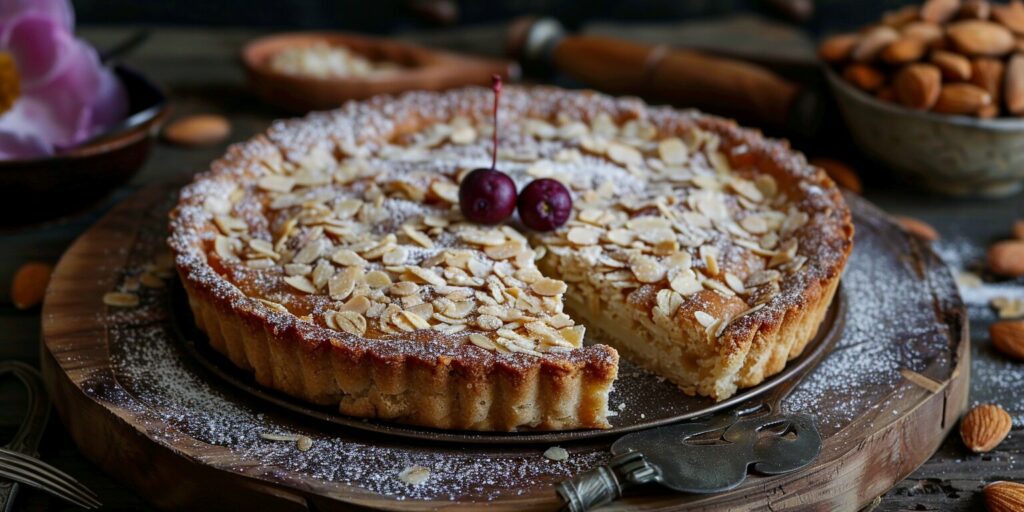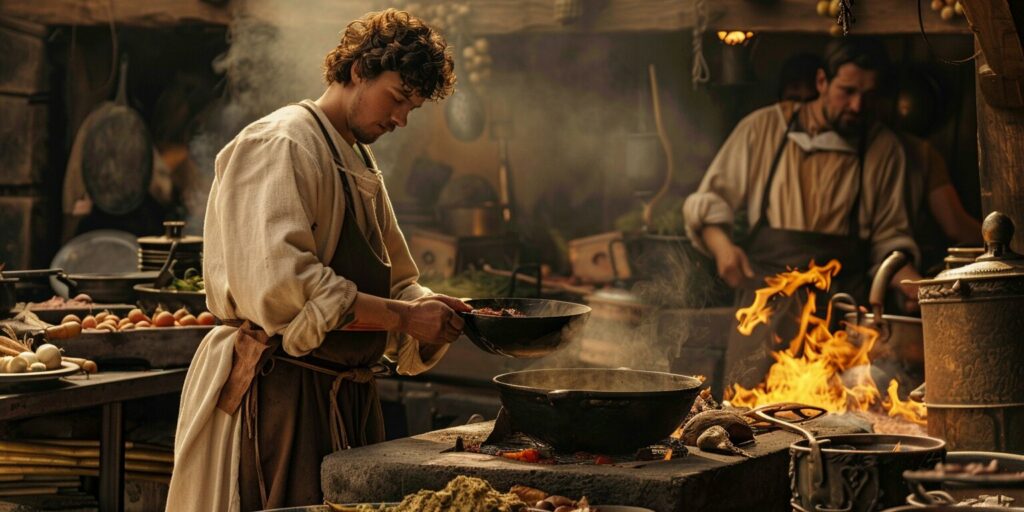Step back in time and embark on a gastronomic journey through the Middle Ages, where the use of thyme, parsley, and black pepper brought simple dishes to life. Medieval cooking, with its rich flavors and unique techniques, offers a fascinating glimpse into the culinary practices of yore, highlighting the importance of spices like clove and thyme.
In this article, we will delve into the world of medieval cooking, unearthing age-old recipes and rediscovering the forgotten art of cookery. From delectable sauces to mouthwatering tarts, we will explore the diverse aspects of medieval cuisine, offering insights into the ingredients, cooking methods, and preferred meats of the era, including the crucial role of frying and the use of an oven. Prepare to savor the tastes of the past as we bring medieval recipes from the Middle Ages back to life. Let’s explore the medieval cookery of the Middle Ages together!
The Role of Sauces in Medieval Cuisine
Sauces played a crucial role in medieval cuisine, both for enhancing flavors and preserving food. They added depth and complexity to dishes, transforming simple ingredients into mouthwatering feasts fit for kings and nobles, often utilizing an oven for baking and a frying technique for meats.
Types of Sauces in Medieval Cooking
Medieval cooks employed a variety of sauces to elevate their dishes. These sauces ranged from vinegar-based concoctions to fruity sweet and sour blends and thickened meat or vegetable-based sauces. Each sauce had a unique purpose and flavor profile, enriching the overall dining experience with hints of black pepper and thyme for added depth.
One commonly used sauce was pan verjuice, crafted from the juice of unripe grapes. Known for its acidity, this sauce added a tangy kick to meats, seafood, and vegetables, bringing freshness and brightness to the medieval palate.
Another beloved sauce was mustard, often combined with vinegar and honey. This combination provided a delightful balance of tanginess, sweetness, and spiciness. Mustard sauce was a staple accompaniment to a variety of meats, including poultry, pork, and beef, adding a zing to every bite.
Whether it was the sharpness of pan verjuice, the complexity of a vinegar-based sauce, or the tantalizing blend of mustard, medieval sauces were an indispensable component of every feast. They enhanced the dishes’ taste and showcased medieval cooks’ culinary skills and creativity.
Tarts: A Staple of Medieval Feasts
Popular Medieval Tart Recipes
Tarts were prominent in medieval feasts and banquets, enjoyed by both the noble class and commoners. These delectable pastries featured a wide range of savory and sweet fillings; all encased in a buttery crust that added a delightful crunch to every bite.
The crust of medieval tarts was often made using salt pastry, a versatile dough known for its ability to create a sturdy and delicious base. Made with flour, butter, water, and a pinch of salt, this pastry provided the perfect foundation for a variety of fillings.
The almond tart was one of the most popular sweet tart recipes from the medieval period. This exquisite treat combined the rich flavors of ground almonds, sugar, and aromatic spices such as cinnamon and nutmeg. The almonds brought a delightful nuttiness and creamy texture to the tarts, while the sugar and spices added a touch of sweetness and warmth.

Whether enjoyed as a sweet indulgence or a savory masterpiece, medieval tarts were a testament to the culinary artistry of the time. Their enduring popularity is a testament to their timeless appeal and the skill of the medieval bakers who created them.
The Art of Medieval Pastry
Techniques and Ingredients in Medieval Pastry Making
Medieval pastry making was a culinary art form that required skill and knowledge of various techniques and ingredients. Pastry was a versatile component of both sweet desserts and savory dishes in medieval cuisine.
One popular type of pastry was almond pastry. Made with ground almonds and sugar, this pastry added a delightful nutty flavor and a delicate texture to medieval dishes. Almond pastry was often used as a base for tarts, pies, and other desserts.
Ginger was another prized ingredient used in medieval pastry making. During the Middle Ages, ginger was highly sought after for its warm and spicy flavor. It was frequently used in pastry recipes to add a touch of warmth and depth, with a sprinkle of sweet spices like clove to enhance the flavors.
Making medieval pastry involved traditional techniques and tools. The dough was often prepared using a mortar and pestle to grind the ingredients together. Lard, a common fat source in medieval cooking, was used in the dough to provide richness and enhance the texture of the pastries.
Almonds: A Versatile Ingredient
Almonds were a staple ingredient in medieval cooking, cherished for their rich flavor and versatility. They were used in a wide array of sweet and savory dishes, adding a distinctive nutty taste and a creamy texture.
Almond milk played a particularly prominent role in medieval cuisine. It was made by grinding almonds with water and served as a popular dairy alternative during the Middle Ages. Its creamy consistency and subtle sweetness made it a favored ingredient in desserts, sauces, and even beverages.
In savory recipes, almonds were often utilized to enhance flavor and texture. They were incorporated into various sauces, adding depth and complexity to dishes. Additionally, almonds were frequently used as a garnish, adding a delightful crunch and visual appeal to the presentation of a meal.
Almonds’ versatility in medieval cooking is evident in their usage across different culinary traditions. Whether it was the delicate almond pastes used in French and Italian confections or the ground almonds featured prominently in Arab and Persian dishes, this beloved ingredient left an indelible mark on medieval cuisine.
Cabbage: The Unsung Hero of Medieval Cookery
Cabbage, a widely available vegetable in medieval Europe, played a significant role in the culinary traditions of the time. It was a staple ingredient in a variety of dishes, including soups, stews, salads, and side dishes, frequently accompanied by peas and carrots for extra nutrition and color. Cabbage’s versatility and adaptability made it a reliable option for sustaining medieval populations, as it could withstand harsh climates and had a long shelf life.
In addition to its practicality, cabbage also offered numerous health benefits and was delicious when gently fried or sweetened with a dash of clove. It is a rich source of vitamins, minerals, and fiber, making it a valuable addition to the medieval diet, often complemented by the subtle flavors of parsley and leek. By consuming cabbage, individuals could ensure they were getting essential nutrients to support their overall health and well-being.

Medieval cooks found many creative uses for cabbage in their recipes. Whether pickled, boiled, or sautéed, cabbage added depth of flavor and texture to a wide range of dishes. Its natural sweetness and crispness made it an excellent complement to hearty stews and soups, creating a well-rounded and satisfying meal.
Today, we can still appreciate the culinary contributions of cabbage in medieval cookery. By incorporating cabbage into our own recipes, we not only pay homage to the flavors of the past but also enjoy the health benefits it provides. From traditional cabbage rolls to modern cabbage slaw, there are countless ways to explore the versatility and deliciousness of this unsung hero, sometimes sweetened with carrots or enriched with peas.
Stewing: A Common Cooking Method
In medieval cuisine, stewing emerged as a prevalent cooking method for preparing both meat and vegetables. This technique allowed for the development of rich flavors and tenderized ingredients, resulting in hearty and satisfying dishes.
One of the staple dishes in medieval cooking was pottage, a thick and nourishing stew that was enjoyed by all social classes. Pottage contained a combination of ingredients such as meat, grains, and vegetables, creating a well-rounded and fulfilling meal.
Medieval cooks employed various methods to thicken pottage to achieve the desired consistency. One technique involved simmering rice flour with the stew, adding thickness and a delicate flavor to the dish. Another method was the addition of stale breadcrumbs, which acted as a binder, creating a dense and satisfying texture.
Stewing allowed for the melding of flavors and enabled the use of more affordable cuts of meat. The slow and gentle cooking process in a stewing pot transformed tough cuts of meat into tender and flavorful morsels, making it an efficient and practical method of cooking during the Middle Ages, with herbs like thyme and black pepper enhancing the taste.
Poultry and Mutton: The Meats of Choice
In medieval cooking, poultry, such as chicken and duck, was highly regarded and often favored by the nobility. Poultry’s versatility allowed for a variety of flavors to be incorporated into dishes, making it a popular choice for medieval cooks. Poultry could be prepared in various ways, including roasting in an oven, boiling, and stewing, allowing for different textures and flavors to be achieved, often enhanced with a sprinkle of black pepper or fresh parsley.

In medieval cuisine, Saffron, a prized and expensive spice, was frequently used to enhance the taste and color of poultry dishes. This vibrant spice added a unique flavor profile and gave the poultry a visually appealing golden hue.
In addition to poultry, mutton, or mature sheep meat, was also commonly consumed during the Middle Ages. Mutton offered a richer and more robust flavor than younger meat cuts, making it a popular choice for medieval recipes. The taste and texture of mutton complemented the bold spices and herbs commonly used in medieval cooking, resulting in hearty and flavorful dishes.
Bringing Medieval Flavors to the Modern Table
While medieval cooking may seem vastly different from modern cuisine, there are ways to incorporate medieval flavors into contemporary dishes. Experimenting with historic ingredients and techniques and connecting with past culinary traditions can add a unique twist to our meals.
One way to bring medieval flavors to the modern table is by using 14th-century cider, a popular beverage during that time. Instead of simply enjoying it as a drink, you can use cider to marinate meats, infusing them with a tangy and slightly sweet flavor. Additionally, adding cider to sauces can give them a unique depth of taste reminiscent of medieval cooking.
The turnip is another ingredient that can transport us back to the Middle Ages. In the 16th century, turnips were a popular root vegetable used in a variety of dishes, frequently seasoned with cloves or paired with leeks for a richer flavor. Today, we can incorporate turnips into stews and salads or roast them to add a distinct flavor and texture to our recipes. It’s a simple way to experience the tastes enjoyed by our ancestors, often by adding a pinch of parsley or a dash of black pepper to recipes.
By embracing medieval flavors in modern cooking, we can not only expand our culinary horizons but also gain an appreciation for the diverse ingredients and techniques that have been used throughout history. So why not give it a try and embark on a journey of exploration, bringing the taste of the past to our present-day meals?
Summary
In this article, we have delved into the fascinating world of medieval cooking, exploring a variety of culinary aspects that defined this era. From sauces and tarts to pastry, ingredients, cooking methods, and preferred meats, we have unraveled the diverse flavors and techniques that shaped medieval cuisine.
The medieval cooking scene was influenced by various factors, including the availability of ingredients, social class distinctions, regional customs, and the use of spices like clove to sweeten dishes. This resulted in a rich tapestry of tastes and culinary traditions that varied across different parts of Europe during the Middle Ages.
By understanding and incorporating the flavors and recipes of medieval cooking into our modern culinary experiences, we can savor the tastes of the past and connect with our rich culinary heritage. Whether it’s experimenting with vinegar-based sauces, crafting savory tarts, or exploring the versatility of almonds and cabbage, embracing medieval cooking allows us to embark on a flavorful journey through time.

